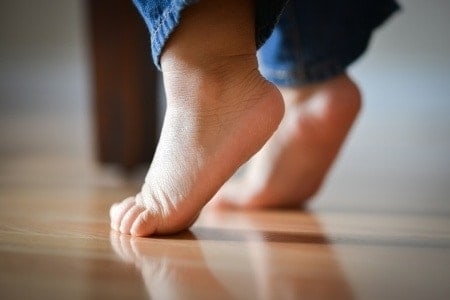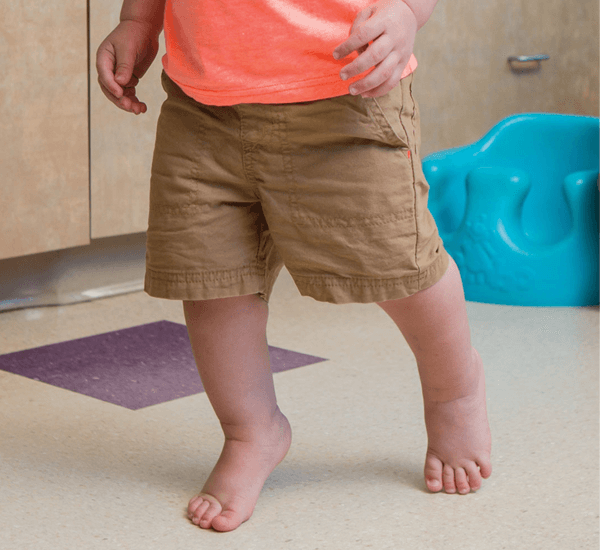Why Do Kids Walk on Tiptoes? Complete Guide to Toe Walking in Children
Why Do Kids Walk on Tiptoes?
A Comprehensive Guide to Understanding Toe Walking in Children
Watching your child take their first steps is one of parenting's most magical moments. But what happens when you notice your little one consistently walking on their tiptoes? If you've found yourself wondering, "Why does my child walk on tiptoes?" you're not alone. Toe walking, medically known as equinus gait, is a common concern that affects many children and can leave parents feeling uncertain about when to worry and when to wait.

Children who consistently walk on their tiptoes may require evaluation and intervention
Toe walking occurs when a child walks on the balls of their feet or toes, keeping their heels elevated off the ground during the stance phase of walking. While this behavior is completely normal during the early stages of walking development, persistent toe walking beyond age two can indicate underlying issues that may require professional attention.
Understanding the difference between normal developmental toe walking and concerning patterns is crucial for parents. This comprehensive guide will explore the various reasons children walk on tiptoes, when you should be concerned, available treatment options, and practical strategies you can implement at home to support your child's healthy gait development.
Understanding Normal Walking Development
Before diving into toe walking concerns, it's essential to understand the typical progression of walking development in children. Learning to walk is a complex process that involves the integration of strength, balance, coordination, and neurological maturation.
The progression of walking milestones from standing to independent walking
The Walking Timeline
Most children follow a predictable sequence of gross motor development:
- 6-9 months: Sitting independently and beginning to pull to stand
- 9-12 months: Cruising along furniture and standing independently
- 12-15 months: Taking first independent steps
- 15-18 months: Walking confidently with improved balance
- 18-24 months: Running, climbing, and refining walking patterns

The journey from first steps to confident walking involves many developmental stages
Normal vs. Concerning Toe Walking
It's important to distinguish between normal, transient toe walking that occurs during early walking development and persistent toe walking that may indicate underlying issues. Many toddlers will occasionally walk on their toes during the first few months of independent walking as they experiment with different movement patterns and develop their sense of balance.
Normal developmental toe walking typically:
- Occurs intermittently, not constantly
- Happens during specific activities like playing or when excited
- Resolves spontaneously by age 2-3 years
- Doesn't interfere with other motor skills development
- Allows the child to walk heel-to-toe when encouraged
In contrast, concerning toe walking patterns may indicate the need for professional evaluation and intervention.
Types and Causes of Toe Walking
Toe walking can be categorized into different types based on its underlying cause. Understanding these distinctions helps healthcare professionals develop appropriate treatment plans and helps parents understand what might be contributing to their child's walking pattern.

Understanding the different types of toe walking helps determine appropriate interventions
Idiopathic Toe Walking
Idiopathic toe walking is the most common form, accounting for approximately 90% of toe walking cases. The term "idiopathic" means that no underlying medical cause can be identified. Children with idiopathic toe walking are otherwise typically developing, with normal muscle tone, strength, and neurological function.
Characteristics of idiopathic toe walking include:
- Persistent toe walking beyond age 3 years
- Ability to achieve heel-to-toe walking when specifically asked
- Normal muscle strength and tone
- No evidence of neurological abnormalities
- Often runs in families, suggesting a genetic component
Neurological Causes
Several neurological conditions can contribute to toe walking patterns. These conditions affect the brain's ability to control muscle tone and coordination, leading to abnormal gait patterns.
Cerebral Palsy
Cerebral palsy is one of the most common neurological causes of toe walking. It results from brain damage that occurs before, during, or shortly after birth. Children with cerebral palsy may have increased muscle tone (spasticity) in their calf muscles, making it difficult to achieve heel-to-toe walking.
Muscular Dystrophy
Duchenne muscular dystrophy and other forms of muscular dystrophy can cause toe walking due to progressive muscle weakness and tightness in the Achilles tendon. This condition typically becomes apparent in early childhood and is accompanied by other signs of muscle weakness.
Spinal Cord Abnormalities
Conditions affecting the spinal cord, such as spina bifida or tethered cord syndrome, can impact the nerve signals that control walking patterns, potentially leading to toe walking behaviors.
Autism Spectrum Disorder and Toe Walking

Research shows a significant connection between autism spectrum disorder and toe walking behaviors
There is a well-documented association between autism spectrum disorder (ASD) and toe walking. Studies indicate that children with autism are significantly more likely to exhibit toe walking behaviors compared to typically developing children. The prevalence of toe walking in children with autism ranges from 20% to 60%, much higher than the general population.
The reasons for this association are complex and may include:
- Sensory processing differences: Children with autism may have altered sensory processing that affects how they perceive and respond to tactile input from their feet
- Repetitive behaviors: Toe walking may serve as a form of self-stimulatory behavior or provide sensory input that is calming or organizing
- Motor planning difficulties: Some children with autism have challenges with motor planning and coordination that may contribute to atypical gait patterns
- Anxiety and stress responses: Toe walking may increase during times of stress, anxiety, or overwhelming sensory environments
It's important to note that toe walking alone is not diagnostic of autism. However, when toe walking is present along with other developmental concerns such as delayed language, social communication challenges, or repetitive behaviors, it may warrant further evaluation by a developmental pediatrician or autism specialist.
Orthopedic Causes
Various orthopedic conditions can contribute to toe walking patterns by affecting the structure or function of bones, joints, and soft tissues in the lower extremities.
Achilles Tendon Tightness
Tightness in the Achilles tendon or calf muscles can mechanically prevent the heel from coming down during walking. This can be congenital or develop over time due to prolonged toe walking, creating a cycle where toe walking leads to further tightness.
Leg Length Discrepancy
Significant differences in leg length may cause a child to walk on tiptoes on the shorter leg to compensate for the height difference.
Congenital Conditions
Certain congenital conditions affecting the foot and ankle structure, such as congenital contractures or bone abnormalities, may predispose children to toe walking patterns.

Normal foot development involves proper alignment and flexibility of all structures
When Should Parents Be Concerned?
Determining when toe walking requires professional evaluation can be challenging for parents. While some degree of experimental toe walking is normal in young children, certain red flags should prompt parents to seek medical advice.

Persistent toe walking in toddlers may require professional assessment and intervention
Red Flags Requiring Immediate Attention
Seek immediate medical attention if your child exhibits:
- Inability to achieve heel-to-toe walking even when asked
- Toe walking that began suddenly after a period of normal walking
- Associated muscle weakness or loss of previously acquired skills
- Signs of pain or discomfort while walking
- Asymmetric toe walking (only on one foot)
- Toe walking accompanied by other neurological symptoms
Age-Based Guidelines
The significance of toe walking varies considerably with age. Here are general guidelines for when to be concerned:
Ages 12-24 Months
Toe walking during this period is generally not concerning unless it's the only way your child walks or is associated with other developmental delays. Many children experiment with different walking patterns as they develop their gross motor skills.
Ages 2-3 Years
If toe walking persists as the primary walking pattern beyond age 2 years, it warrants evaluation. Children should be able to walk heel-to-toe consistently by this age, especially when specifically asked to do so.
Age 3+ Years
Toe walking beyond age 3 years is considered persistent and typically requires professional evaluation and intervention. At this age, the walking pattern should be well-established, and continued toe walking may indicate underlying issues.
Associated Developmental Concerns
Toe walking becomes more concerning when it occurs alongside other developmental issues. Parents should seek evaluation if toe walking is accompanied by:
- Delayed language development
- Social communication difficulties
- Repetitive behaviors or restricted interests
- Sensory processing challenges
- Motor coordination difficulties
- Balance problems or frequent falls
- Muscle stiffness or weakness
Family History Considerations
A family history of toe walking, autism spectrum disorders, or other developmental conditions may increase the likelihood that persistent toe walking requires intervention. Genetic factors can play a role in both idiopathic toe walking and associated developmental conditions.
Parents should inform healthcare providers about any family history of:
- Toe walking in siblings or parents
- Autism spectrum disorders
- Learning disabilities or developmental delays
- Neurological conditions
- Muscular or orthopedic conditions
